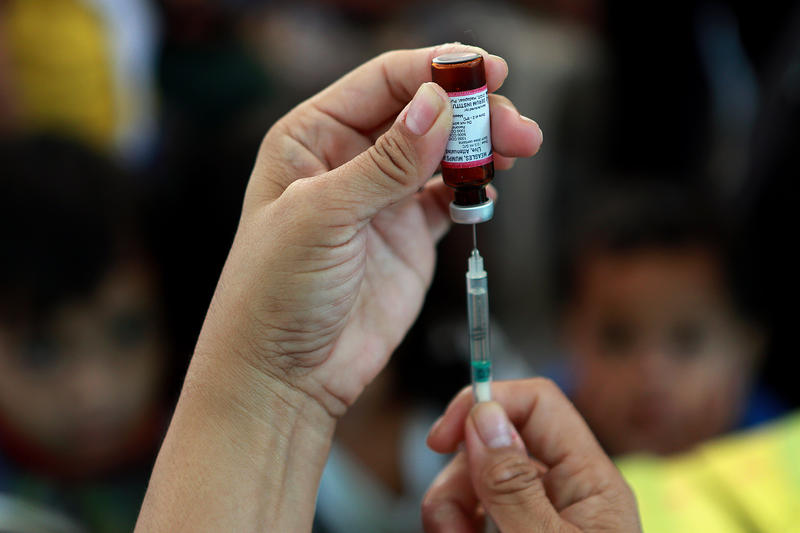
Black teachers: How to recruit them and make them stay

Lessons in higher education: What California can learn

Keeping California public university options open

Superintendents: Well-paid and walking away

The debt to degree connection

College in prison: How earning a degree can lead to a new life

California Governor Gavin Newsom and state lawmakers hammered out an agreement Friday that will keep alive legislation that tightens restrictions on medical exemptions that allow students to attend school without having all the required vaccinations.
In exchange for his signature on Senate Bill 276, the governor asked for a slate of revisions in the form of a second bill that would loosen some restrictions and tighten others. The bill must move through the Legislature before Sept. 13, which is the deadline for the current legislative session.
“These amendments clarify legal and administrative processes in SB276 in order to ensure medical providers, parents, school administrators and public health officials know the rules of the road once it takes effect,” according to a statement from the governor’s office. “The Governor will sign SB276 once the companion legislation has passed both houses.”
Senate Bill 276 calls for a review of a medical exemption for the following reasons:
The bill also requires the state Department of Public Health to develop a standardized electronic medical exemption form, prohibits physicians from charging families for filling out a form or for a physical examination related to renewing a temporary medical exemption and establishes an appeals process for medical exemptions that are revoked.
The new piece of legislation proposed by Newsom, Senate Bill 714, maintains those changes. However, there are several key addendums. Among them:
The governor also softened language in Senate Bill 276 that would require a doctor to certify “under penalty of perjury” that the statements in the form are accurate and complete. According to Newsom’s proposal, a doctor only must certify that the statements are accurate and complete, without the threat of perjury.
The revisions come on the heels of raucous protests at the Capitol in Sacramento from parents and activists in opposition to the bill.
Under state law, children must be immunized against 10 serious communicable diseases if they want to attend public or private schools and child care centers. Studies have linked clusters of unvaccinated children to outbreaks of measles, pertussis and chicken pox.
Sen. Richard Pan, D-Sacramento, authored both Senate Bill 276 and Senate Bill 277, which eliminated the personal belief exemption in 2015.
“As the latest measles outbreak threatens the country’s elimination status, California acted to keep children safe at school by abolishing non-medical exemptions,” Pan said in a statement. “Unfortunately, a few unscrupulous physicians are selling inappropriate medical exemptions and we need SB276 stop the corruption of medical exemptions that endanger children. I appreciate the governor’s commitment to sign SB 276 with amendments contained in SB 714 that we both agree upon to ensure we maintain the community immunity needed to protect our kids.”
Medical exemptions have gone up fivefold since 2011, to 4,812 in 2018, according to a recent EdSource analysis of hot spots with low vaccination rates. Pan said that many of the exemptions are clustered in the same schools, creating pockets of unvaccinated students who undermine the state’s overall high vaccination rates.
This post was corrected to reflect the fact that students with medical exemptions issued before Jan. 1, 2020 are not subject to the new restrictions when they change schools, only at vaccination checkpoints.

Legislation that would remove one of the last tests teachers are required to take to earn a credential in California passed the Senate Education Committee.

Part-time instructors, many who work for decades off the tenure track and at a lower pay rate, have been called “apprentices to nowhere.”

A bill to mandate use of the method will not advance in the Legislature this year in the face of teachers union opposition.

Nearly a third of the 930 districts statewide that reported data had a higher rate of chronic absenteeism in 2022-23 than the year before.
Comments (1)
Comments Policy
We welcome your comments. All comments are moderated for civility, relevance and other considerations. Click here for EdSource's Comments Policy.
Rachel 4 years ago4 years ago
Can you clarify when the checkpoints are imposed? For example, my daughter who has a medical exemption prior to 2019 is entering kindergarten this Fall 2020. The bill states, "The bill would instead allow a child who has a medical exemption issued before January 1, 2020, to be allowed to continue enrollment until the child enrolls in the next grade span, as specified, and would prohibit, on and after July 1, 2021, a governing authority … Read More
Can you clarify when the checkpoints are imposed? For example, my daughter who has a medical exemption prior to 2019 is entering kindergarten this Fall 2020. The bill states, “The bill would instead allow a child who has a medical exemption issued before January 1, 2020, to be allowed to continue enrollment until the child enrolls in the next grade span, as specified, and would prohibit, on and after July 1, 2021, a governing authority from unconditionally admitting or readmitting to these institutions, or admit or advance any pupil to 7th grade level, unless the pupil has been immunized or has a medical exemption through a procedure that includes the completion of a compliant statewide form.”
Because it says “and it would prohibit on or after July 2021, it makes me think the checkpoints will be enforced then. Thoughts?